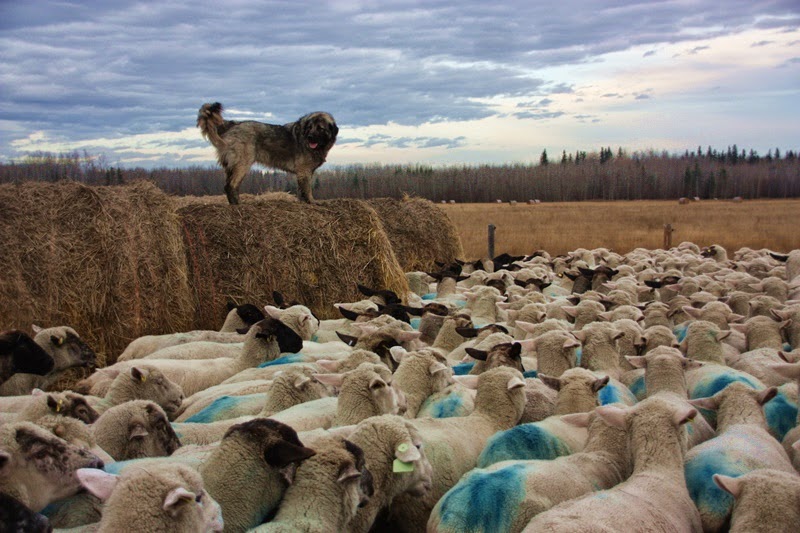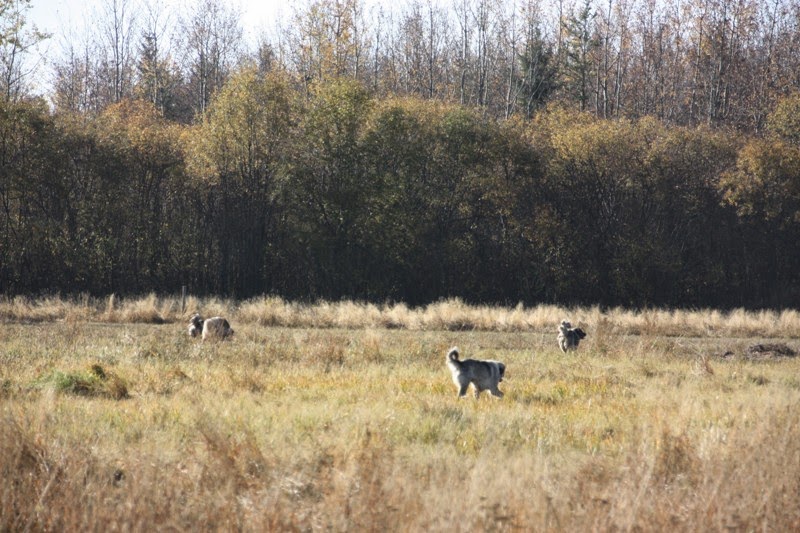So often the question arises;
what are some of the biggest
differences between certain breeds of LGD?
These questions are tough to answer!
Not only is it difficult to compare each breed,
but one really also needs to take into account;
the experience level of the owner,
or the experience the owner has in working with LGD,
or, even livestock knowledge.
Temperament is so difficult to define,
we could easily get lost in the semantics, the words and definitions.
So finding the correct wording or even scale to define qualities such as aggression level, bonding, proximity to stock etc
adds another dimension to making a fair comparison.
Temperament consists of a balance of various traits, that defines the job a LGD needs to do.
For each person, that job varies.
Each person works and raises their
dogs in a different way,
some people find training a LGD a little easier than others,
and this certainly affects how we view the dogs.
Our own bias makes comparing a difficult task as we lean in a certain direction or value a certain trait higher.
Understanding these factors, makes making comparisons a tricky business.
Gross generalisations is of course, not really
the “right” thing to do,
for every generalisation one makes,
hundreds of
exceptions will be found.
Coppinger, in his early study of LGD tried to do a breed comparison,
the USDA is
now testing various breeds in an attempt to quantify certain
characteristics of certain breeds to the task of protecting livestock from wolves.
I do believe the general rule of thumb is:
if you look at the map of Europe and
move from west to east,
the breeds tend to get harder the further East you go.
Why would this be?
Perhaps it has to do with the number of years that the
wolf has been extirpated in certain countries!
It is only since the 1990’s that
wolves have really started drifting from Italy back into the French Pyrenean Mountains, with an estimated 2005 population of about 90.
Many of the Great Pyrenees dogs have not seen or faced a wolf
for generations and generations in their home country.
Most have probably not even smelt a wolf or a bear,
the nurturing nature has probably been selected for over aggressiveness toward predators,
simply due to the lack of predator pressure for many generations.
Italy has been a stronghold for wolves in
Europe when many other countries had extirpated them.
In 2006 the estimated population
of wolves in Italy was about 500.
The Maremma would rate higher on my scale for protectiveness and aggression than the GP.
The Swiss Alps may be home to just a handful
of wolves.
In Romania, further east the wolf population rises to 2500 animals
and Russia with its huge land mass has
25 000-30 000 wolves,
and is home of the Ovcharkas.
Canada has estimated population 52,000-60,000 wolves,
and the USA has, in the lower 48: 5368 gray wolves and in Alaska 7 700- 11 200
( US Fish and Wildlife stats 2012).
I have not even taken into account any other predators such as the brown bear or lynx.
The predator density will play a big role in the selection of aggression and ferocity of LGD.
I do believe, it is primarily, the wolf,
that has shaped the evolution of our LGD.
So, here is the disclaimer before I make a generalised comparison between the Sarplaninac and the great Pyrenees Dog.
All I say
here is MY opinion, based on my own bias, experience and preconceived ideas.
This is made from my experience, with dogs I know
and does not reflect every Sarplaninac nor every Great Pyranees dog.
There is no statistical logic in any of my comparisons!
(It is also hard to make comparisons when you have a huge population of GPs
and a handful of working sarplaninacs).
Nothing is intended to insult or be hurtful,
as I said, for every generalisation made,
there are, always exceptions to the rule.
So this
is what I think and I know it is a very slippery slope to go down..
What would be the biggest differences between a GP and a
Sarplanianc?
In a random order:
|
GP
|
Sarplaninac
|
Size
|
Maybe a bit larger
|
Medium to large
|
Colour
|
Mostly white
|
Mostly grey
|
Sharpness/fierceness
|
low
|
high
|
Activity
|
low
|
high
|
Roaming
|
high
|
medium
|
Barking
|
more
|
less
|
Nurturing to livestock
|
higher
|
medium
|
Patrolling
|
Less
|
Medium
|
Aggression towards predators
|
lower
|
High
|
Ease to train
|
easier
|
harder
|
Courage
|
Medium
|
High
|
Protectiveness
|
Low to medium
|
High
|
Drive
|
low
|
Medium to high
|
Suspicion of strangers
|
Low to Med
|
Med to high
|
Easy
to train to fences
|
low
|
High
|
Intelligence
( tricky)
|
Med
|
High
|
Conflicts
with predators/success rate:
|
Low-Med
|
I would put my money on a shar.
|
Toughness
|
Low to Med
|
High
|
Rough
with stock in training period
|
lower
|
medium
|
Health
status
|
lower
|
higher
|
Availability
|
high
|
low
|
Athleticism
|
low
|
Med to high
|
So, these are just a few of the parameters I looked at ( I am sure there are a whole lot more...).
I personally believe there are enough
breeds to select from,
to find, the right breed for your operation.
I am not really a believer in cross breeding,
as I cannot understand the logic behind it,
given you have a choice and opportunity to various breeds.
If a certain breed is not suitable;
due to its body type, or coat length or working style or aggression level,
then perhaps,
the breed you are looking at,
is not the right breed for you.
Cross breeding to tone up or tone down a breed is senseless.
Genetics is never 50%,
you never get that perfect blend of characteristics!
If you are on a
small holding, are dealing with low predator pressures, have young kids on a
mixed small livestock operation a GP may be exactly what you need.
If you are on a range situation , you may prefer the Akbash.
 |
| Akbash in Canada |
You may need more athleticism, so take a better look at an Anatolian.
If your
climate is hot and you prefer a shorter coat,
then a Kangal maybe the perfect fit for you.
 |
| Kangal dog that we imported to Canada clearing a fence, he rates high for athleticism! |
If your predator load is higher and you need a little more force, combined with a closer bonding type of dog, then a Maremma may
be the right choice for your operation.
High predator load, with possibilities for conflicts, then perhaps a higher drive
Sarplanianc is the dog for you.
Dealing with domestic dogs as predators or with
human thieves perhaps the CAS should be a consideration?
Availability is also an issue, perhaps only certain breeds are readily available and you may just have to make do with what you have.
So many breeds, so many differences, so many choices!
 |
| Our Sarplanianc Fena |
The choice of breed, depends on so many factors; how your operation is run, set up, size, livestock.
Perhaps the most important in your decision making process,
is the affinity you have
for a certain breed.
If you do not like the breed to start with,
the chances of you
making it work will be less.
I like the medium size, the strong will, the
balanced body, the grey rough coat, suitability to our climate and the activity level of the sarplaninac.
Despite the sar being high drive, and having a higher aggression temperament,
they are balanced and they know when to use it.
Within our operation, and predator
pressure,
the sarplaninac is the “right” dog for us.
I am positive that there are at least 5 other breeds that would suit us just fine,
but right now,
this is the breed for us.
 |
| Sarplaninac Lucy running off to ward of a coyote. |
Each breed brings a unique balance of “skills” to the proverbial table,
and to the discerning buyer,
the right breed is "out there"!
 |
| Sarplaninac is well equipped to deal with our Canadian winters. |
While writing this, I realise,
that there is a lot more to say about this topic
and a lot of information missing.
I think, I may revisit this topic sometime in the future.
Please feel free to share ideas and thoughts with me.
Happy Thanksgiving to all my Canadian Friends!











































